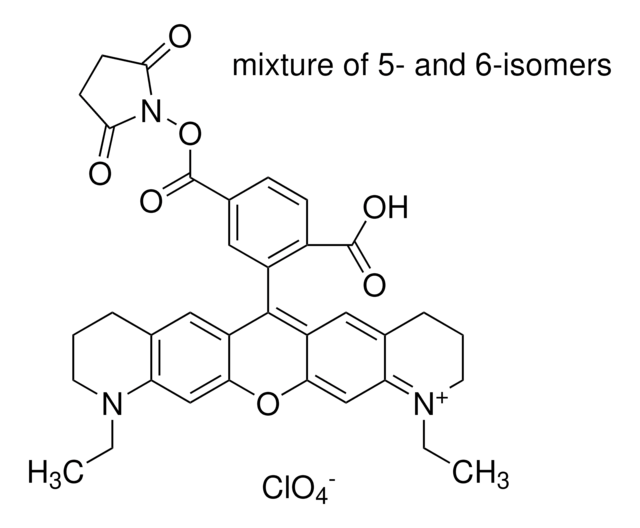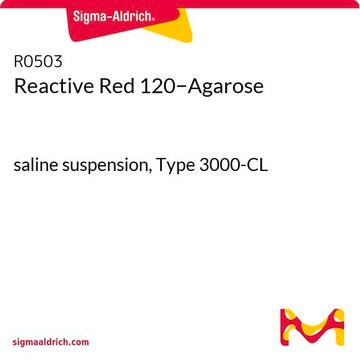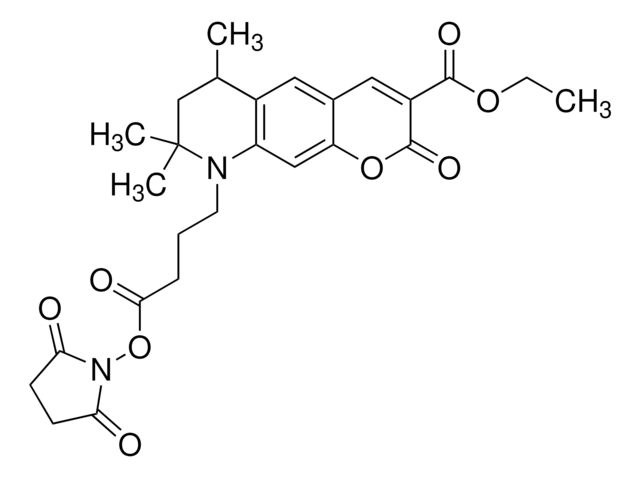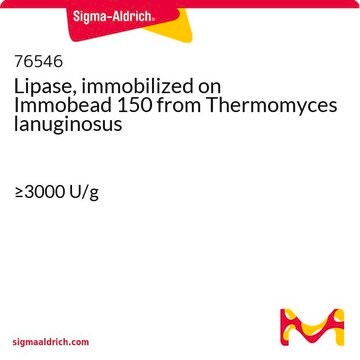88793
Atto 532 NHS ester
BioReagent, suitable for fluorescence, ≥90% (HPLC)
Synonym(s):
Atto 532
Sign Into View Organizational & Contract Pricing
Select a Size
All Photos(1)
Select a Size
Change View
About This Item
Recommended Products
product line
BioReagent
Assay
≥90% (HPLC)
≥90% (degree of coupling)
form
powder
manufacturer/tradename
ATTO-TEC GmbH
λ
in methanol: water (1:1) (with 0.1% perchloric acid)
UV absorption
λ: 532-538 nm Amax
suitability
suitable for fluorescence
storage temp.
−20°C
Related Categories
General description
Atto 532 NHS ester is a fluorescent dye related to the well-known laser dye, Rhodamine 6G. The fluorescence activity is excited efficiently at the 515-545nm range. A suitable excitation source for Atto 532 is the 532 nm output of the frequency-doubled Nd: YAG laser.
Application
Atto 532 NHS ester is highly suitable for single-molecule detection applications and high-resolution microscopy such as PALM, dSTORM, and STED. In addition, the dye is used in flow cytometry (FACS) and fluorescence in-situ hybridization (FISH) methods.
Features and Benefits
Characteristic features of the Atto 532 NHS ester are:
- Strong Absorption.
- High Fluorescence quantum yield.
- High Photostability.
- Excellent water solubility.
Storage Class Code
11 - Combustible Solids
WGK
WGK 3
Flash Point(F)
Not applicable
Flash Point(C)
Not applicable
Personal Protective Equipment
dust mask type N95 (US), Eyeshields, Gloves
Choose from one of the most recent versions:
Already Own This Product?
Find documentation for the products that you have recently purchased in the Document Library.
Customers Also Viewed
Rumelo Amor et al.
Scientific reports, 4, 7359-7359 (2014-12-09)
Standing-wave excitation of fluorescence is highly desirable in optical microscopy because it improves the axial resolution. We demonstrate here that multiplanar excitation of fluorescence by a standing wave can be produced in a single-spot laser scanning microscope by placing a
Kiyoto Kamagata et al.
Journal of the American Chemical Society, 134(28), 11525-11532 (2012-06-14)
A method was developed to detect fluorescence intensity signals from single molecules diffusing freely in a capillary cell. A unique optical system based on a spherical mirror was designed to enable quantitative detection of the fluorescence intensity. Furthermore, "flow-and-stop" control
Moritz Marcinowski et al.
Nature structural & molecular biology, 18(2), 150-158 (2011-01-11)
The endoplasmic reticulum is the site of folding, assembly and quality control for proteins of the secretory pathway. The ATP-regulated Hsp70 chaperone BiP (heavy chain-binding protein), together with cochaperones, has important roles in all of these processes. The functional cycle
Toshiro Saito et al.
Nanotechnology, 22(44), 445708-445708 (2011-10-13)
We fabricated platinum bowtie nanostructure arrays producing fluorescence enhancement and evaluated their performance using two-photon photoluminescence and single-molecule fluorescence measurements. A comprehensive selection of suitable materials was explored by electromagnetic simulation and Pt was chosen as the plasmonic material for
Daniel Aquino et al.
Nature methods, 8(4), 353-359 (2011-03-15)
We demonstrate three-dimensional (3D) super-resolution imaging of stochastically switched fluorophores distributed across whole cells. By evaluating the higher moments of the diffraction spot provided by a 4Pi detection scheme, single markers can be simultaneously localized with <10 nm precision in
Our team of scientists has experience in all areas of research including Life Science, Material Science, Chemical Synthesis, Chromatography, Analytical and many others.
Contact Technical Service







